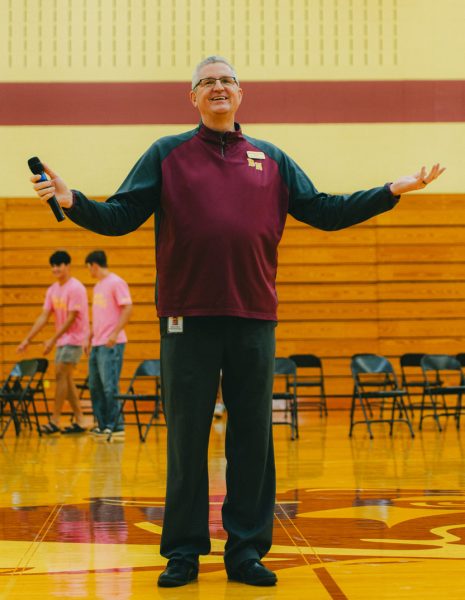Fulbright Scholars: Education from Pole to Pole
Botswana Native and English teacher Gaone Moloi poses for a portrait.
This year, North has some special visitors walking its halls. Through the Fulbright scholar program, 21 international teachers were selected to come to Bloomington for educational enrichment. These teachers come from all over the world, and they teach all different age groups in all different types of schools.
However, it isn’t easy to get chosen. To do so, participants have to go through a number of extensive steps. Although it differs from country to country, the overall process involves an online application, being shortlisted, an interview, and final results.
For some, it is even harder. Gaone Moloi, a teacher from Botswana, had to go through several extra steps, as this is her first time visiting the U.S.
“I applied, I was called for the interview, and I had to wait for months before the response,” she said, “I had to go apply for the visa to come here, I had to go for some medical examinations, unfortunately, and before I left my country I went through a series of orientation.”
Marina Basu, a math and science teacher from India, said she had to go through extensive interviews to get chosen.
Basu teaches at an English medium school called The Valley School. Hidden in a valley and surrounded by 100 acres of forest the school, where she has taught for seven years, is private and based upon nontraditional teaching styles.
Many classes are held outside, and between lessons the students climb trees, play games, and talk to their friends. In the walls are huge open windows curtained in mesh; a safeguard between the children and the large monkey population in the area. Many people from around India come to her school’s campus to birdwatch and experience the beautiful scenery.
Whereas North, and many other American schools, rely on textbooks and learners from an early age, there are no textbooks used in the school until the high school level, and those that are used stay in the building.
Not only are textbooks not used, but calculators are only allowed for high level math when explicitly needed. The students usually do all of the calculations themselves.
Basu grew up in India and attended a Catholic missionary convent. Before becoming a teacher, she worked in economics, but went back to school later on to get her teaching degree.
“Because I had grown up in a very mainstream school, I had not liked that traditional system of teaching, where the teacher was standing and teaching and there was a lot of focus on exams and all of that,” Basu said. “That’s why I had never wanted to become a teacher.”
After spending some time at North, Basu was surprised by some of the things she saw.
First, she noticed passing periods. She said that after observing students moving from class to class, she was reminded of the crowds at Indian train stations.
“This is something I don’t see in my school at all because there’s one classroom here, and then there’s this little bit of grass and tree roots,” Basu said. “At my school it is completely based in the nature, the curriculum comes from it, the classrooms have huge windows.” She was also surprised that some classrooms at North don’t have windows.
She said that the public schools in India would be more similar to American public schools, but there is still a greater sense of freedom in Indian schools.
As for why Basu decided to come here, she wanted educational enrichment for herself and her students back home.
All Fulbright Scholars came here working on a project. Basu’s project, entitled “Strategies for Math Learning for First Generation ESL Learners,” aims to ‘deepen her theoretical and practical understanding of the specific challenges that first generation ESL students face in mathematics classrooms as well as explore effective strategies to enhance their learning.’ She was also surprised that some classrooms at North don’t have windows.
She said that the public schools in India are similar to American public schools, but there is still a greater sense of freedom in Indian schools. Basu’s fellow scholar, Botswana native Gaone Maloi, is also focusing on a project related to English.
Maloi is an English and literature teacher in Maoka Junior Secondary School, a public school located in Gaborone, Botswana. She has been teaching there for 10 years. She has a Bachelor’s degree in English and history and teaches 13-16 year olds.
Her project, called ‘Making English Learning Fun and Easy with Computers,’ focuses on using technology to advance learning and appreciation of English and improving their grades across all subjects.
At North, we are very accustomed to using technology on a daily basis, whether it is a phone, iPod, laptop, or other device, many forms of technology are used for enhancing an distracting from the learning process. However, not all schools use technology as heavily, if at all.
Moloi said that at her school, some 700 students have access to one computer room, which they use for various daily lessons. At Basu’s school, they also have a computer lab, which students use sporadically. Neither school allows students to have cell phones or computers with them during the day.
Moloi said that she would like to take that integration of technology that she sees at North back to her school. She finds some of the ways we use technology fascinating, and is interesting in teaching her students in more technologically advanced methods of learning.
Though these are only perspectives from two different countries, they give us a unique look into international education. Many classes at these women’s schools are taught in English, but they are very different from the way things are taught at North. Which methods would you like best?







